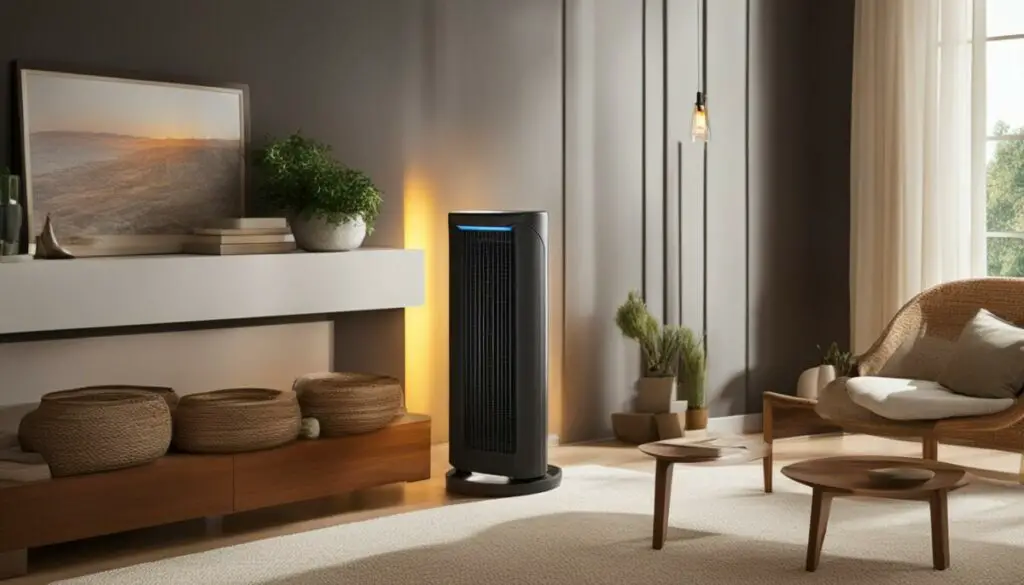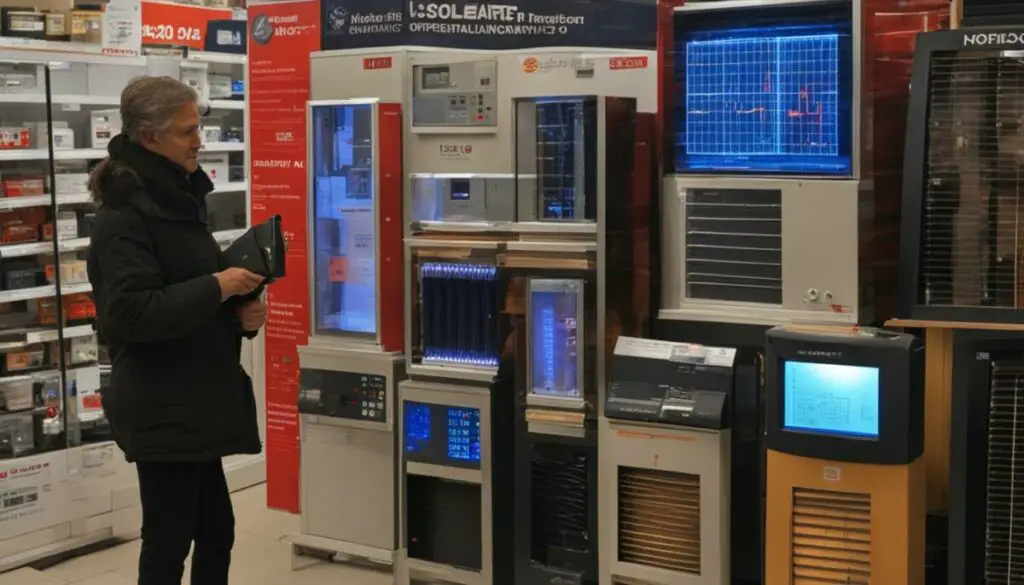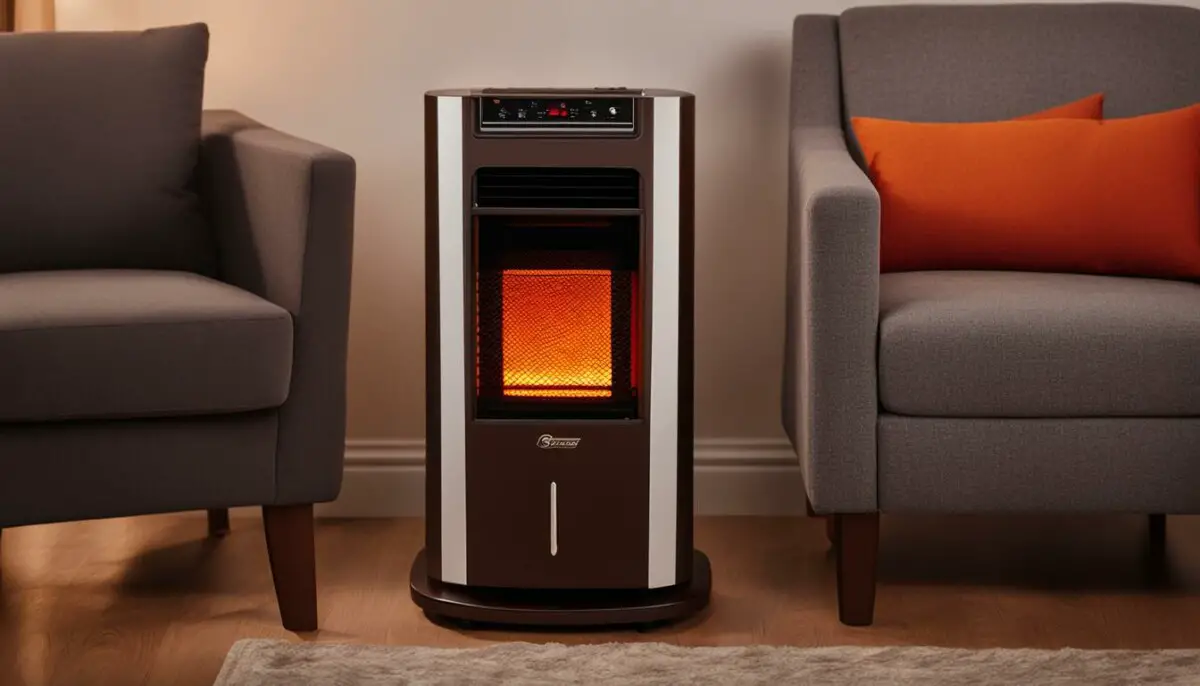Last Updated on 4 months by Francis
When it comes to heating your home, finding a solution that is both cost-effective and energy-efficient is crucial. If you’ve been considering investing in an infrared quartz heater, you may be wondering if they are expensive to operate. In this article, we will delve into the cost of operating infrared quartz heaters and explore their energy efficiency to help you make an informed decision.
Contents
Key Takeaways:
- Infrared quartz heaters can provide cost-effective heating solutions for your home.
- The operating cost of an infrared quartz heater depends on factors such as power consumption, electricity rates, and usage hours.
- By taking advantage of the infrared-specific advantages and adjusting the heat settings, you can potentially lower your energy consumption and save on running costs.
- Consider your specific heating needs, location, and budget when deciding whether an infrared heater is the right choice for you.
- Infrared quartz heaters offer a comfortable and instant heat, while being energy efficient and environmentally friendly.
Power Consumption of Infrared Heaters

When considering the cost of operating an infrared heater, understanding its power consumption is crucial. In the United States, most infrared heaters consume 1,500W of power. However, in Europe and the UK, higher wattage models are available, offering even more efficient heating capabilities.
The power consumption of an infrared heater directly impacts its running cost. To estimate the running cost, we need to consider the electricity rate, which varies by location. In the United States, the electricity rate typically ranges from around 10 to 30 cents per kilowatt-hour (kWh).
To calculate the running cost of an infrared heater, we can multiply its power consumption (in kilowatts) by the electricity rate. Let’s take a closer look at the hourly, daily, and monthly estimated costs for an infrared heater based on the average power consumption in the US:
| Power Consumption (kW) | Electricity Rate (cents/kWh) | Hourly Cost ($) | Daily Cost ($) | Monthly Cost ($) |
|---|---|---|---|---|
| 1.5 | 10 | 15 | 120 | 3,600 |
| 1.5 | 15 | 22.5 | 180 | 5,400 |
| 1.5 | 20 | 30 | 240 | 7,200 |
| 1.5 | 30 | 45 | 360 | 10,800 |
Keep in mind that these are estimated costs based on the average power consumption and electricity rates. Your actual running costs may vary depending on the specific wattage of your infrared heater, usage hours, and the electricity rate in your location.
In the next section, we will explore the various factors that can affect the cost of running an infrared heater, helping you make a more informed decision about its economic viability as a heating solution.
Factors Affecting the Cost to Run an Infrared Heater

Infrared heaters offer specific advantages that contribute to their cost-effective operation. These infrared-specific advantages include:
- Intermittent Shut-Off: Infrared heaters are equipped with an automatic shut-off feature that prevents overheating. This functionality not only ensures safety but also helps save on electricity costs by avoiding continuous full power usage.
- Directional Heat Output: Infrared heaters emit heat in a targeted and directional manner. This focused heat distribution allows for lower heat settings while still delivering the same level of warmth. By utilizing lower heat settings, you can decrease the electricity cost of operating an infrared heater while maintaining a comfortable environment.
These advantageous features of infrared heaters can result in a notable reduction in electricity costs. In fact, by adjusting the heat settings and taking advantage of the directed heat output, you can potentially achieve a 20-40% decrease in energy consumption compared to continuous full power usage.
By implementing these cost-saving measures, infrared heaters prove to be an energy-efficient solution for heating your space while minimizing electricity costs.
| Infrared-Specific Advantages | Influence on Electricity Cost |
|---|---|
| Intermittent Shut-Off | Reduces continuous full power usage, leading to electricity savings. |
| Directional Heat Output | Allows for lower heat settings, resulting in decreased energy consumption and cost. |
Comparing Infrared Heater Running Costs by Location
The running cost of an infrared heater can vary depending on the location and the electricity rate. The average electricity rates differ across countries. Let’s take a look at the rates in different regions:
Electricity Rates
| Location | Electricity Rate |
|---|---|
| United States | 16 cents per kWh |
| Canada | 12 cents per kWh |
| Europe | 25 Euro-Cents per kWh |
| United Kingdom | 52p per kWh |
Once you know the electricity rate, you can estimate the running costs of your infrared heater. By multiplying the electricity rate by the running duration in hours, you can calculate the hourly, daily, and monthly costs of operating the heater in different locations.
Here’s an example of how you can estimate the running costs:
Let’s say your infrared heater consumes 1.5 kW of power and you run it for 4 hours a day.
Hourly cost = Electricity rate x Power consumption = 16 cents per kWh x 1.5 kW = 24 cents
Daily cost = Hourly cost x Running duration = 24 cents x 4 hours = 96 cents
Monthly cost = Daily cost x 30 days = 96 cents x 30 = $28.80
Remember that these calculations are approximate and may vary based on your specific electricity rates and usage patterns.
To give you a better understanding of the running costs, refer to the table below, which shows the estimated monthly costs of operating an infrared heater for different running durations:
Monthly Running Costs
| Running Duration (hours) | United States | Canada | Europe | United Kingdom |
|---|---|---|---|---|
| 4 | $28.80 | $21.60 | €45 | £93.60 |
| 6 | $43.20 | $32.40 | €67.50 | £140.40 |
| 8 | $57.60 | $43.20 | €90 | £187.20 |
| 10 | $72.00 | $54.00 | €112.50 | £234.00 |
Keep in mind that these values are based on the average electricity rates and should be used as a reference to gauge the monthly costs in different locations.
The Benefits of Infrared Heaters

Infrared heaters offer several benefits that make them an appealing choice for home heating.
- Comfort: Infrared heaters provide comfortable warmth without drying out the air, creating a cozy environment for your home.
- Instant Heat: As soon as you turn on an infrared heater, it starts emitting infrared light, offering instant heat without waiting for the unit to warm up.
- Energy Efficiency: Infrared heaters are highly energy efficient, transferring at least 90% of the energy they produce directly to the objects in the room. This efficient heat transfer results in lower energy consumption and reduced heating costs.
- Environmentally Friendly: Unlike traditional heating methods that rely on carbon combustion, infrared heaters produce no carbon emissions or toxic byproducts. They are a clean and environmentally friendly heating option.
- Low Maintenance: Infrared heaters require minimal maintenance, making them a hassle-free choice for home heating. They typically have no moving parts and do not require regular cleaning or servicing.
Overall, infrared heaters provide a comfortable and energy-efficient heating solution for your home, while being environmentally friendly and low maintenance.
Considerations Before Purchasing an Infrared Heater

Before investing in an infrared heater for your home, it’s important to consider a few factors that can help you make an informed decision. By understanding the unique benefits and features of infrared heaters, you can determine if they are the right heating solution for your needs. Here are some key considerations to keep in mind:
Zone Heating
One of the main advantages of infrared heaters is their ability to provide zone heating. Unlike central heating systems that warm the whole house, infrared heaters can be used to target specific areas or rooms that need heating. By focusing the heat where it’s needed, you can maximize energy efficiency and reduce your overall heating costs.
Appliance Backup
Infrared heaters can also serve as a reliable backup heating option in case of HVAC system failure. This is particularly useful during power outages or when your primary heating system malfunctions. Having an infrared heater as a backup ensures that you have a source of warmth to rely on, allowing you to stay comfortable even during unexpected situations.
Energy Bill Savings
Using infrared heaters for zone heating can lead to significant energy bill savings. By heating specific areas only when needed, you can avoid wasting energy on heating unoccupied spaces. This targeted heating approach can help reduce your overall energy consumption and lower your monthly utility bills.
Allergies
The gentle heat produced by infrared heaters is beneficial for individuals with allergies or asthma. Unlike traditional heating systems that circulate air and disturb airborne particles, infrared heaters do not disrupt the indoor air quality. This makes them a suitable choice for those who are sensitive to allergens and want to maintain a clean and healthy living environment.
Safety Mechanisms
Modern infrared heaters are equipped with safety mechanisms that prioritize your well-being and provide peace of mind. These mechanisms include features such as automatic shut-off when the heater is tipped over, overheating protection, and cool-touch exteriors to prevent burns. These safety measures make infrared heaters a safe heating option, especially for households with children or elderly individuals.
By considering these factors, you can determine if an infrared heater aligns with your heating needs and requirements. Whether you’re looking for zone heating, a backup heating option, energy bill savings, allergen-friendly heating, or enhanced safety mechanisms, infrared heaters offer a range of benefits that make them a compelling choice for efficient and comfortable home heating.
Comparing Infrared Heaters to Other Portable Heaters

When it comes to portable heaters, infrared heaters are just one option among a variety of choices available in the market. It’s important to consider the features and benefits offered by different types of portable heaters before making your decision. Let’s take a look at some popular alternatives to infrared heaters:
Ceramic Heaters
Ceramic heaters are known for their focused heating capabilities. They use a ceramic heating element to provide targeted warmth, making them an excellent choice for individual comfort. Additionally, ceramic heaters typically stay cool to the touch, reducing the risk of accidental burns.
Convection Heaters
If you’re looking to warm up an entire room quickly, convection heaters are a great option. These heaters work by circulating air and creating a flow of warm currents throughout the space, ensuring efficient heat distribution.
Electric Heaters
Electric heaters are known for their rapid warming capabilities. They can quickly generate heat, providing instant comfort in chilly environments. However, it’s important to note that electric heaters may consume larger amounts of energy compared to other types of portable heaters.
Fan-Forced Heaters
Fan-forced heaters offer the advantage of adjustable airflow, allowing you to customize the temperature according to your preference. Even after being turned off, these heaters continue to provide warmth, making them ideal for maintaining a comfortable environment.
Oil-Filled Radiant Heaters
If you’re in search of a quiet and energy-efficient heating option, consider oil-filled radiant heaters. These heaters use oil as a heat reservoir, slowly radiating warmth into the surrounding space. Oil-filled radiant heaters are a great choice for those seeking a peaceful and eco-friendly heating solution.
When choosing the right portable heater for your needs, it’s essential to consider factors such as the size of the space you want to heat, specific heating requirements, and your budget. Each type of portable heater has its own advantages and disadvantages, so make sure to weigh your options carefully before making a decision.
This image illustrates the various types of portable heaters, including infrared heaters, ceramic heaters, convection heaters, electric heaters, fan-forced heaters, and oil-filled radiant heaters.
Cost Comparison of Infrared Heaters and Other Portable Heaters
When considering the cost of heating options, it’s essential to analyze both the purchase cost and running cost of different types of heaters. In the case of infrared heaters, their price range can vary significantly, with models available from as low as $50 and going up to $500.
However, to get a complete picture of the expenses associated with operating an infrared heater, one must consider factors such as power consumption and electricity rates. The running cost of an infrared heater depends on its specific wattage, usage hours, and the electricity rate in your location. By comparing these factors, you can determine the most cost-effective heating option for your needs.
To better understand the cost comparison, let’s take a closer look at the factors involved:
1. Purchase Cost:
The purchase cost of an infrared heater can vary based on the brand, features, and wattage. While some models may start at $50, premium infrared heaters with advanced functionalities can cost up to $500. It’s important to consider your budget and heating requirements when selecting a heater.
2. Running Cost:
The running cost of an infrared heater is influenced by its power consumption and the electricity rates in your area. To estimate the running cost, multiply the power consumption (in kilowatts) by the electricity rate. Usage hours also play a crucial role in determining the monthly running cost. By accounting for these factors, you can make an informed decision and manage your energy expenses efficiently.
3. Energy Savings:
Although the initial purchase cost of an infrared heater may be higher compared to other portable heaters, they offer potential energy savings. Infrared heaters are designed to emit heat that is absorbed by objects in the room, resulting in efficient and targeted heating. This focused heating method can potentially reduce overall energy consumption and contribute to long-term energy savings.
4. Electricity Rates:
The electricity rates in your location have a direct impact on the running cost of any electric heating device, including infrared heaters. It’s crucial to consider the current electricity rates and any potential fluctuations when analyzing the cost-effectiveness of different heating options. Electricity rates can vary depending on your region, so it’s important to factor this into your decision-making process.
When comparing the cost of operating infrared heaters to other types of portable heaters, it’s important to consider the wattage and energy consumption of each option. Additionally, evaluating the potential energy savings and factoring in the electricity rates in your location will help you make a well-informed decision.
Here’s a visual representation of the cost comparison between infrared heaters and other portable heaters:
| Heater Type | Purchase Cost | Running Cost | Energy Savings |
|---|---|---|---|
| Infrared Heaters | $50 – $500 | Depends on wattage, usage hours, and electricity rates | Potential energy savings through efficient, targeted heating |
| Ceramic Heaters | $30 – $150 | Depends on wattage, usage hours, and electricity rates | Varies depending on the model |
| Convection Heaters | $50 – $200 | Depends on wattage, usage hours, and electricity rates | Varies depending on the model |
| Electric Heaters | $30 – $150 | Depends on wattage, usage hours, and electricity rates | Varies depending on the model |
| Fan-Forced Heaters | $40 – $200 | Depends on wattage, usage hours, and electricity rates | Varies depending on the model |
| Oil-Filled Radiant Heaters | $80 – $250 | Depends on wattage, usage hours, and electricity rates | Varies depending on the model |
As you can see, the cost-effectiveness of infrared heaters compared to other portable heaters depends on various factors. To make an informed decision, analyze the purchase cost, running cost, potential energy savings, and electricity rates in your location.
Conclusion
In conclusion, infrared quartz heaters offer a cost-effective and energy-efficient heating solution for your home. Although the initial purchase cost may be higher compared to other portable heaters, the operating cost of infrared heaters can vary depending on factors such as power consumption, electricity rates, and usage hours. By taking advantage of the infrared-specific advantages and adjusting the heat settings, you can potentially lower your energy consumption and save on running costs.
When considering the benefits of infrared heaters, it’s important to assess your specific heating needs, location, and budget. Infrared heaters provide comfortable warmth without drying out the air and offer instant heat as soon as they are turned on. Additionally, they are environmentally friendly, energy efficient, and require little maintenance.
Ultimately, the decision to choose an infrared quartz heater should be based on your individual circumstances. By analyzing the operating cost, energy efficiency, and advantages of infrared heaters, you can make an informed choice that best suits your heating requirements. Whether you’re looking for zone heating, lower energy consumption, or a heating option for individuals with allergies, infrared quartz heaters deliver efficient, cost-effective, and environmentally friendly warmth to your home.
FAQ
Are infrared quartz heaters expensive to operate?
The cost of operating an infrared quartz heater depends on factors such as power consumption and electricity rates. While the initial purchase cost may be higher compared to other portable heaters, infrared heaters can provide cost-effective and energy-efficient heating solutions in certain situations.
What factors affect the cost to run an infrared heater?
The running cost of an infrared heater can be affected by infrared-specific advantages such as intermittent shut-off and directional heat output. By adjusting the heat settings and taking advantage of these features, you can potentially lower your energy consumption and save on running costs.
How can I compare infrared heater running costs by location?
The running cost of an infrared heater depends on the electricity rate, which varies by location. By multiplying the electricity rate by the running duration, you can estimate the hourly, daily, and monthly running costs of an infrared heater in different locations.
What are the benefits of infrared heaters?
Infrared heaters provide comfortable warmth without drying out the air and offer instant heat. Additionally, they are energy efficient, environmentally friendly, and require little maintenance.
What considerations should I make before purchasing an infrared heater?
Before purchasing an infrared heater, consider using it for zone heating or as a backup heating option. Additionally, infrared heaters are a good option for individuals with allergies or asthma due to their gentle heat that does not disturb airborne particles. Modern infrared heaters also come with safety mechanisms for household safety.
How do infrared heaters compare to other portable heaters?
Infrared heaters are just one type of portable heater available on the market. Other options include ceramic heaters, convection heaters, electric heaters, fan-forced heaters, and oil-filled radiant heaters. Each type has its own unique features and benefits.
How does the cost of infrared heaters compare to other portable heaters?
The cost to operate an infrared heater depends on factors such as power consumption and electricity rates. It is important to compare the running cost of infrared heaters to other types of portable heaters based on their wattage and energy consumption.
What is the conclusion about the operating cost of infrared quartz heaters?
The operating cost of infrared quartz heaters can vary depending on factors such as power consumption, electricity rates, and usage hours. While the initial purchase cost of an infrared heater may be higher compared to other portable heaters, they can provide cost-effective and energy-efficient heating solutions in certain situations.








